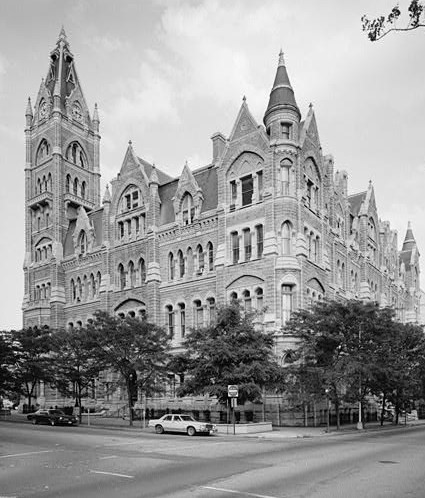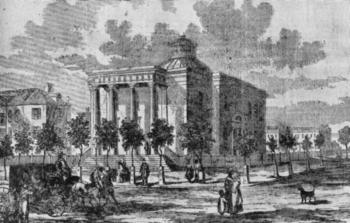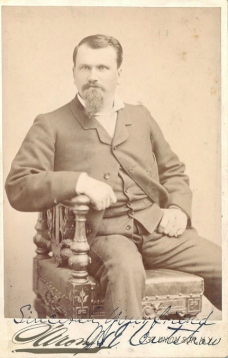 Most of the time when we pass Old City Hall on Broad Street on one our tours, people ask me: “Which Church is That?” And my response… Gothic Architecture was en vogue in 1894 when that was built to house the workings of the Richmond City Government. This venerable building, like most large construction projects, did not go as smoothly as its interested parties would have hoped.
Most of the time when we pass Old City Hall on Broad Street on one our tours, people ask me: “Which Church is That?” And my response… Gothic Architecture was en vogue in 1894 when that was built to house the workings of the Richmond City Government. This venerable building, like most large construction projects, did not go as smoothly as its interested parties would have hoped.
In 1881 the city council and the city office staff were all working out a very undersized building with cramped quarters. This was never meant to be a permanent solution to housing the offices, but small budgets and other civic needs had caused the council to put off building a larger building.
The reason for this temporary situation was because the building that housed the city offices from 1816 until 1874 had been torn down due to concerns over its stability. These concerns stemmed from an 1870 incident in which Richmond had a municipal civil war over who was the rightful mayor of Richmond George Chahoon or Henry K Ellyson. Chaos ensued, shots were fired, and even a couple of bystanders died. This all lead to a trial in the capitol building where the upper gallery collapsed, killing some and injuring many more. After this, all of Richmond’s antebellum public buildings were suspect and many torn down. Including the Robert Mills designed City Hall.
In November of 1881, it was decided that something had to be done and the City finance committee proposed to appropriate the mammoth sum of $300,000 for the construction of the building which was approved by a popular referendum of the city’s voters.
With the political will and the budget to move forward with the project, bids for designs were solicited and after some debate, the council decided on Elijah Meyers and his very contemporary Gothic revival design as it was the most handsome and cost effective proposal.
Not everybody was keen on this idea. There were some who envisioned this as a giant boondoggle and assumed that it would be mismanaged, way over schedule, and far over budget.
One of the big questions was where to put this building. There was an empty lot where the previous City Hall was, but it was not big enough for this new building. Former Governor Edmund Randolph’s house was demolished from the block. The 1st Presbyterian Church which was on the corner of that block block near the previous hall was moved to the corner of Madison and Grace St…. piece by piece.
They had a location – the next question was who would build it. Initially, the people tapped to build it were outside contractors who would come into Richmond to shape the stone and construct the edifice.
At this time, local Richmond stone masons were clamoring for work. With so many skilled tradesmen in the city, why would you hire someone else to come in and build it? That city council ended up getting booted out of office in favor of a labor union friendly City Council that wanted this built using local labor and local material.
The project would be Superintended by venerated City engineer Wilfred Emory Cutshaw. Cutshaw was a former Confederate Officer who had his leg amputated 3 days before Lee’s surrender at Appomattox in 1865. He was the City Engineer who oversaw the development of the Boulevard, the Byrd Park reservoir, the first electric streetcar system in the country, and a multitude of Richmond’s Guilded-Age feats of engineering.
The foreman for the stonework portion would be James Netherwood, a Quarry Owner on the James River near what is today River Road. In fact, almost all of the Granite for this 140x170x 195 foot tall building was locally obtained from quarries along the James River near Petersburg, and was shaped by local workers under the Netherwood’s direction. Richmond would build horse-drawn rails from a train station at Broad and Pine St. directly to the construction site to accommodate this movement of materials.
Cutshaw and Netherwood would oversee this project using local laborers and locally sourced building materials to be a boon for the region.
This all seemed very good….. In theory.
Tensions began early on in the project with the question of which local laborers would be used. This was the height of the power of labor unions in Richmond. Most of the unions in Richmond were affiliated with the Knights of Labor, the largest national labor union in the United States. They were so influential that they electioneered to remove the 1881 city council that sought to bring in outside laborers for the project. In fact, the Knights of Labor held their 1886 convention in Richmond.
The Knights of Labor, being founded in the North, insisted on social equality between working class African Americans and working class whites. The local chapters of the unions affiliated with the Knights of Labor in Richmond were not so keen on this ideal. In fact, there were no black workmen on this site per a resolution passed by the city council banning the employment of African American mechanics.
Obviously, this didn’t sit well with the African American workmen, who were just as qualified and skilled as the white ones. The African American laborers did everything they could to affect a change in this policy. They leveraged African American councilmen, including James Hayes. Making no progress, the next step was to confront City Engineer Cutshaw about this to which he responded that it was a union job and there were no African Americans in the union. What Cutshaw failed to acknowledge was the fact that African Americans weren’t allowed in the union. A few months later on 1887, the city council gave in and allowed African American workmen to be hired for the project, though this went largely ignored anyway.
Finally, in 1887, a cornerstone laying took place. There was a parade organized by the anti-labor Law-and-Order League with all of the Civic Groups marching in it. Continuing a long tradition, the corner-stone was laid by the Freemasons.
After 7 years of labor, and a lot of delays, the final product was unveiled in 1894. It was roundly accepted as one of the most beautiful structures in the City. Adding to this was the interior cast iron work by another specialist, Richmond iron founder, Asa Snyder, who cast the grills and fencing along with the magnificent cast iron atrium, a masterpiece of cast iron architecture.
All of this marvelous construction and magnificent detail led to a total final construction cost of $1.3 million dollar.
Four times the $300,000 budget originally set aside for it’s construction.
There were several reasons for this, the least of which wasn’t the opulent cast-iron decoration of the interior, the higher cost of union labor brought about by the labor-friendly city officials, and Councilmen buying “expensive” decorations for their offices from supporters,
Shortly after its construction, the maintenance problems began. In the haste to build it and minimize the huge costs, some of the work was done in a slip-shod manner and by 1915, just 20 years after its’ completion, there was a movement to tear down the out-dated structure to build a modern beaux-arts style building that was more in line with contemporary tastes.
The Hall remained.
Again, in 1970, with the construction of our current city hall with even more offices, the city was going to demolish Old City Hall as it was becoming too expensive to maintain after 77 years. Preservationists led by the Historic Richmond Foundation stepped in and facilitated the selling of the building to the state for $1 and helped raise funds to restore it. It can be visited during regular business hour.


